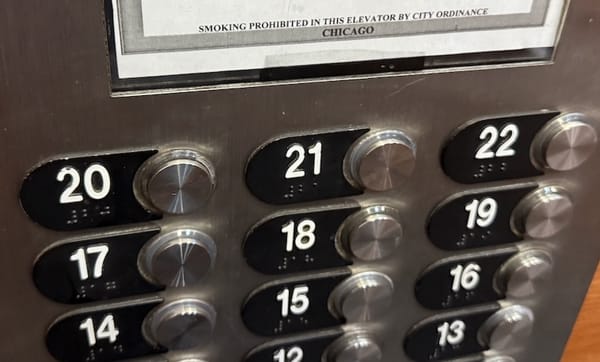The Amidah Project: Three a Day the RJ Way
A reader asked how a Reform Jew can learn to pray Judaism's traditional three weekday prayers. Here's my guide on using Mishkan T'filah, the current RJ prayerbook, to do just that.

This post is part of my Amidah Project series--an attempt to examine my personal experience of the core prayers of the normative Reform Jewish liturgy. For more, please browse my Amidah Project archive.
I had a planned a different post for today, but last night I responded to an interesting question from a reader with whom I'm friended on Facebook. He asked me how a Reform Jew goes about beginning to pray in the traditional manner, three times a day. In case other folks out there share the same concern, with his permission, I've included his original question and my answer below.
For those of you for whom this is relevant, may sharing our conversation help your experience of the Jewish liturgy deepen. As you go into it, so may it go into you, too.
Shabbat Shalom.
Question: Okay Michael, I'm stumped. Maybe you can help. I'm looking for resources/instructions for davening. I'm an observant, liberal Jew, and I have read about how others who are similarly affiliated daven three times a day. I've searched the 'net but haven't found anything substantive about how to get started. I have the Mishkan T'filah [Ed. note: The current Reform Jewish prayerbook] sitting here next to me, but I'll be a monkey's uncle if I can figure out how to use it at home for personal davening (for now--davening with minyans may come later).
Do you daven? If so, in the absence of a guide to davening for reform Jews, do you follow a Conservative or Orthodox siddur instead? Or is there a reform or reconstructionist siddur/method that I may have overlooked? Any tip would be welcome. I'm spinning my wheels trying to find information on this topic. It's weird that I cannot seem to find guidance on this. Sadly, I don't have a rabbi at the moment.
Thanks.
Answer: Hi. Glad to help. I used to try to daven three times a day, but now it's closer to once (in the morning) or not at all. It goes in waves for me, and I can see it becoming closer to twice a day as the year progresses. It's a living process for me, I guess. I will tell you, learning the weekday liturgy very greatly deepened my understanding and experience of Jewish prayer. May you be blessed with a similar experience.
[Ed. note: use of tefillin (as pictured above) and a tallit are traditional when praying on weekday mornings. For more about my experience with them see: The Amidah Project: Laying Tefillin–Wearing Your Prayer on Your Sleeve (Video) and The Tallit of Phillip Shenkler.]
So...
You're overthinking "rules of davenning." No need for anything but MT (which is what I use, as well.) I daven at home, though I have a standing invitation to morning minyan at a conservative shul.
Each of the three services include the T'filah and follow the familar, three-part pattern you know from Shabbat: preliminary prayer (which varies between morning, afternoon, and evening); the T'filah; then the Aleinu.
Weekday mornitng prayer is very similar to Shabbat morning. Weekday evening is very similar to Shabbat evening without the Kabbalat Shabbat psalms. And midday is really short and sweet.
MT actually tells you the page numbers to start at in the contents (on page vii), and if the T'Filah doesn't directly follow, at the end of the service it tells you what page to skip to for the T'filah. Here are the pages:
- MORNING SERVICE (SHACHARIT): Pages 23-100, 586.
- AFTERNOON SERVICE (MINCHA): Pages 52, 57, 74-100, 586.
- EVENING SERVICE (MA'ARIV/aka ARVIT): Pages 2-21, 74-100, 586.
Here are some additional notes you may find helpful to make additional sense out of MT...
GENERAL NOTES:
- You probably know this already, but the main content in MT is generally on the right-facing page only, followed by the next right-facing page, unless the page spread has a blue line all the way around both pages to tell you not to skip the left page. (Mostly, you find this in preliminary psalms, such as in the Kabbalat Shabbat pages.)
- For the weekday services, you will ALWAYS use the T'Filah on pages 74-100.
- As you probably also already know, the Aleinu us always on 586.
- There is no Sh'ma in the Afternoon Service.
NOTES ON THE T'FILAH:
- The weekday version of the T'Filah is longer than the Shabbat version. Don't let this throw you. It's actually very beautiful to learn the weekday blessings.
- Just like on Shabbat, the weekday T'Filah has two version of the Kedushah. Use the longer morning Kedusha only for the Morning Service, otherwise you can use the shorter version.
- Also like on Shabbat, the T'Filah includes morning and evening versions of the Shalom rubric. Use Sim Shalom in the morning service and Shalom Rav in the other services.
That's about it, other than to say you need not feel like you "have" to do every single prayer, psalm, and rubric, or "have" to use Hebrew or the transliterations instead of the English translations, which are halachically acceptable (though not always exact translations.) I don't do everything, and I change up Hebrew vs. English and, sometimes, the rubrics I do, too. (Rubric is just a fancy name for section.) As you engage in weekday prayer, your heart and conscience will guide you to your liturgical comfort zone.
That could mean a silent, fast, abbreviated service that takes you 10 minutes, or a fully chanted, slow, long service that takes you half an hour. I'm partial to the latter, especially in the morning. Have fun finding your version of weekday prayer.
Let me know if this helps and please don't be shy about follow-up questions either.
Shabbat Shalom!




